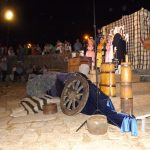An interesting article published at the Dalmatinski Portal, part of a series about ancient fortresses – conservator Ivan Alduk writes about the interesting Nutjak Fortress near Trilj. Here is a part of the article. Read the whole article here.
The Trilj area is where the Cetina river ends its peaceful flow through the fields and starts its second part, through the canyon to Omiš. Prehistoric ruins, like Križina in Vedrine, Stražbenica at Gardun, Svalina fort in Čaporice and numerous other finds, primary those from the bed of the river testify the importance of this area during the earliest period of human history. To control river crossings, but even for much broader strategic political issues, the Romans placed the camp of their VII. legion right here, i.e. at the nearby Gardun (Tilurij) in the first years after Christ. Even a bridge was built over Cetina river (Pons Tilurii).

Trilj is mentioned by the medieval sources for the first time in the early 13th century and later becomes part of the estate “Brodarić” or the “Trilj Boat” within the Cetina principality. This possession was given to an aristocrat Petar Dražojević in 1456 and the area to Gradun became the northernmost part of the Poljica Principality. Thirty years later, precisely between 1482 and 1492, Petar´s son Žarko built the castle “Nutjak” to defend the northern entrance to Poljica from the Turks and guarded the bridge near the fortress. Nutjak was the only real fortress in Poljica. In the next few decades, Žarko Dražojević with his stratiots (lightly armed horsemen) became one of the most prominent Croatian leaders in the fight against the Turks. The fortress was also serving as a base for incursions deep into the Turkish territory.
On January 15, 1508 was Žarko Dražojević riding with his escort to Sinj carrying aid for the city, but behind Klis stormed into a Turkish ambush, where he died. He was 70 years old. He was buried in the Split Cathedral and there is a ledger above his grave (today in front of the baptistery), which shows him as a medieval knight-rider. The Nutjak fortress was offered to the Venice Republic to manage and was then known as the “tomb of the poor guys, who were sent to defend it”. The Turks conquered the Nutjak fortress in 1513 and kept a small military camp for a short period of time.
In the first half of the 17th century, there is a little village nearby and a few smaller villages and hamlets. Nutjak was left by Turks in 1685.
Nutjak Fortress was built downstream from Trilj on the edge of a smaller rocky plateau, that rises high above the right bank of the Cetina river. The entrance is at the western rampart and was further defended by a low pre-wall and loopholes preserved at the rampart. Beyond the entrance, there is a little courtyard and a passage, which was leading to three rooms on the cliffs in the southern and eastern part of the fortress. Stairs lead to the access road of the tower and to the entrance to the largest room of the fortress. A circular tower dominates the entire structure and protects it from the north (land) side.

The fortress can be reached from the Trilj-Bisko road, by a path from the Živaljići hamlet – 15 minute walk to the edge of the canyon and the fortress. Be aware, that by visiting the fortress, you are doing it at your own risk.










